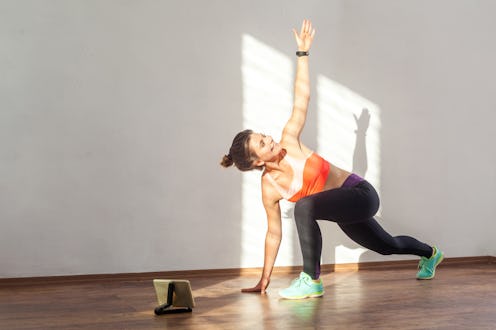Fitness
Meet The "World's Greatest Stretch"
It does everything.

There’s a wildly popular warm-up movement called “the world’s greatest stretch”, and it actually lives up to its name as one of the — if not the — best stretches you could do, especially right before a workout. Trainers say the bendy move is packed with benefits that get your body ready to run, cycle, lift, or whatever else you’ve got planned for the gym.
To break it down, the world’s greatest stretch is a dynamic stretching exercise that combines a lunge with a torso twist to target several muscle groups at once, including the hip flexors, hamstrings, glutes, spine, and chest, says personal trainer Michael Hamlin, NSCA, CSCS. Most stretches zero in on one specific muscle, but this move truly targets everything. “There are so many different movements in this warm-up exercise that it looks and feels like a blend of athletics and yoga,” he tells Bustle.
While you can do the stretch whenever you want to unwind tight muscles, it’s extra beneficial before a workout because of the way it prepares your body to move, says Hamlin. The flowing motion activates key muscles and gets your blood pumping, he says, which is why it can help prevent injuries, too.
“Often the first time [someone] does this exercise, they will mention to me how everything feels ‘loose,’” says Hamlin, who dubs it an “essential part of any dynamic warm-up routine.” Keep reading for details on how to do the world’s greatest stretch, plus all of its benefits.
How To Do The World’s Greatest Stretch
Here, Peloton instructor Rebecca Kennedy explains how to do the world’s greatest stretch with good form:
- Stand with your feet hip-distance apart.
- Forward fold and reach for your toes.
- Take a slight bend in your knee, if you need to.
- Walk your hands out into a high plank position.
- Step your right leg forward into a runner’s lunge with your foot outside of your hands.
- Reach your right arm up to the ceiling and twist your torso for a T-spine rotation.
- Place both hands back on the ground.
- Step your legs back into a plank.
- Step your left foot forward and repeat the runner’s lunge and T-spine rotation on the left side.
- Place both hands back down.
- Walk your hands back to your feet, then slowly roll back up to standing.
- Repeat four slow reps on each side.
Benefits Of The World’s Greatest Stretch
The world’s greatest stretch moves your body through its full range of motion, which means it effectively hits every muscle group so that you feel ready to tackle a tough workout.
Gliding forward into a lunge warms your hip flexors, glutes, hamstrings, and quads while the torso twist and arm reach hit your core, mid-back, shoulders, chest, and arms, says Lalitha McSorley, PT, a personal trainer and physical therapist. “It helps to activate the muscles to prepare them for the workout ahead,” she tells Bustle.
If you’re running short on time or aren’t sure which stretches to do, the world’s greatest stretch is always a good choice. It’s quick, it’s easy, and Hamlin says you might even feel more mobile and powerful than usual as you exercise, thanks to the way it effectively warms you up.
Beyond being a pre-workout move, this full-body stretch also improves your flexibility, mobility, and posture, McSorley says, since it lubes up your joints and lengthens tight muscles in one go. And because it requires you to balance while you twist, Hamlin notes it’s a nifty way to boost your stability, too. In other words: It’s called the world’s greatest stretch for a reason.
Studies referenced:
Afonso, J. (2021). Time to Move From Mandatory Stretching? We Need to Differentiate "Can I?" From "Do I Have To?". Front Physiol. doi: 10.3389/fphys.2021.714166.
McHugh, MP. To stretch or not to stretch: the role of stretching in injury prevention and performance. Scand J Med Sci Sports. 2010 Apr;20(2):169-81. doi: 10.1111/j.1600-0838.2009.01058.x. Epub 2009 Dec 18. PMID: 20030776.
Page, P (2012). Current concepts in muscle stretching for exercise and rehabilitation. Int J Sports Phys Ther. PMID: 22319684; PMCID: PMC3273886.
Sources:
Michael Hamlin, NSCA, CSCS, personal trainer
Lalitha McSorley, PT, personal trainer, physical therapist
Rebecca Kennedy, Peloton instructor
This article was originally published on